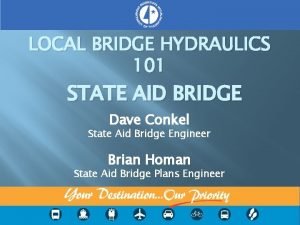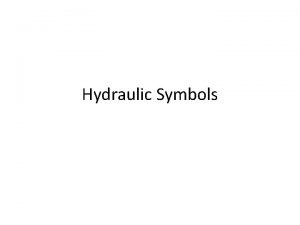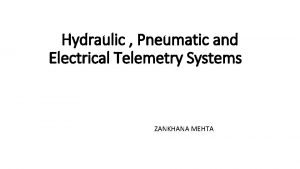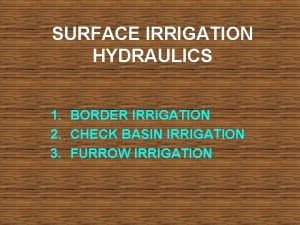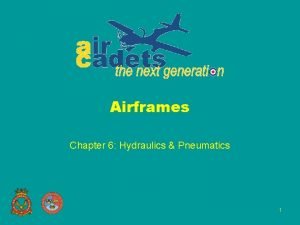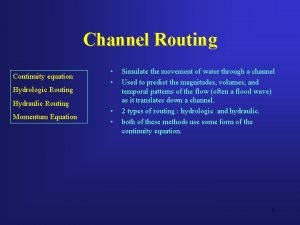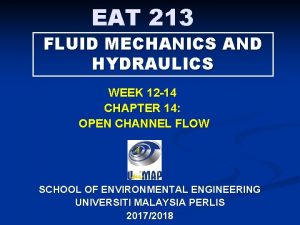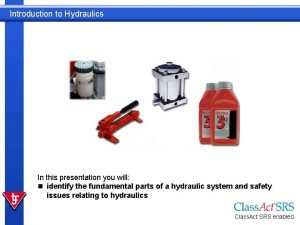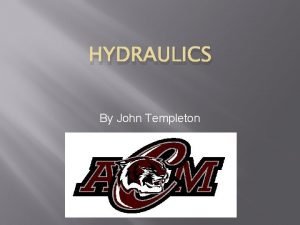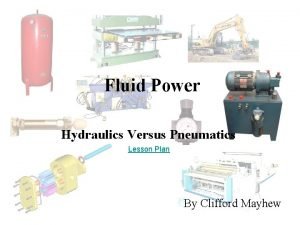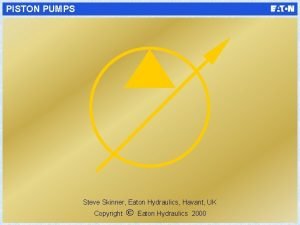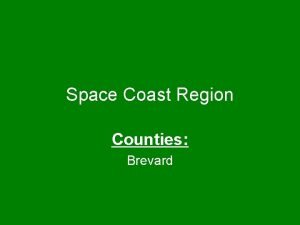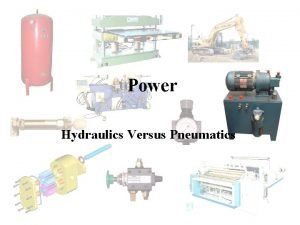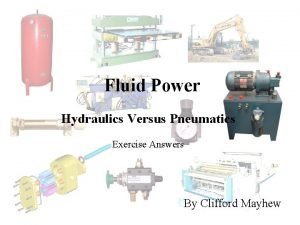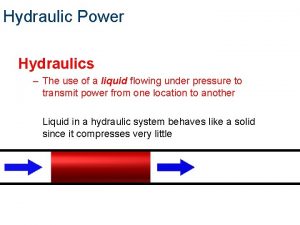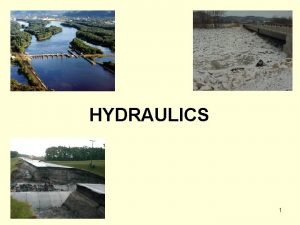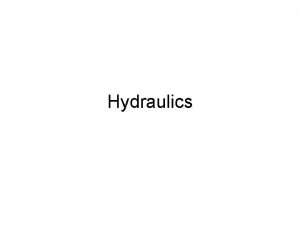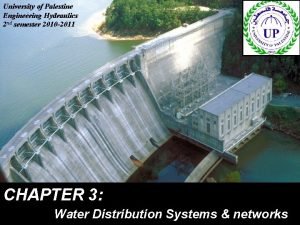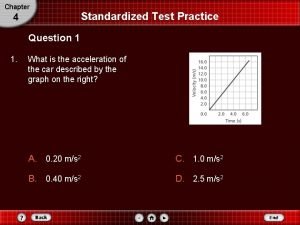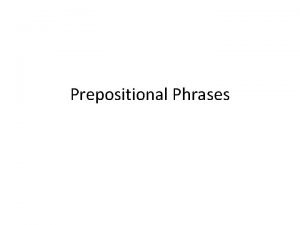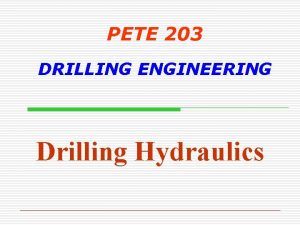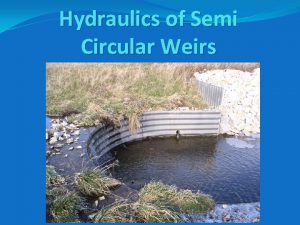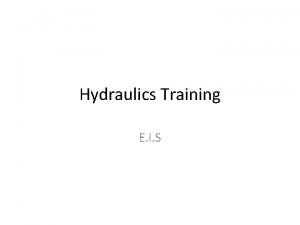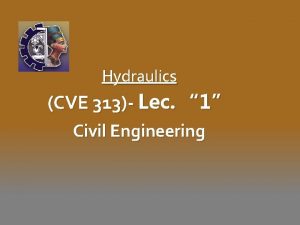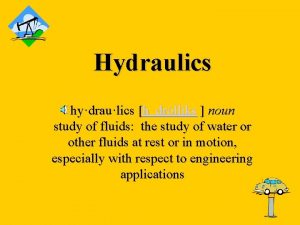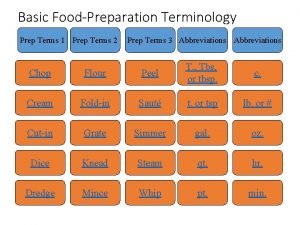PREP COURSE IN HYDRAULICS E O AKINYEMI Prep









































![Classification of Flow (b) Uniform vs. Varied: [space as the criterion] n Flow is Classification of Flow (b) Uniform vs. Varied: [space as the criterion] n Flow is](https://slidetodoc.com/presentation_image/64f197aa2427095d325869f352a35d99/image-42.jpg)


















- Slides: 60

PREP. COURSE IN HYDRAULICS E. O. AKINYEMI Prep. Course in Hydraulics

This Basic Hydraulics course provides: n n an understanding of basic hydraulics. all participants with materials for future reference. Prep. Course in Hydraulics

In This Part n n Types of Conduits and their hydraulic properties Characteristics of Different types of flow in conduits Prep. Course in Hydraulics

At The End of This Part n YOU SHOULD BE ABLE TO : n IDENTIFY THE CHARACTERISTICS OF DIFFERENT TYPES OF WATER CONDUITS n IDENTIFY THE CHARACTERISTICS OF FLOW IN DIFFERENT TYPES OF CONDUITS Prep. Course in Hydraulics

Types of Conduits n There are two main types of water conduits: n n Pipe systems and Open Channels. Prep. Course in Hydraulics

Pipes n n Pipes are closed conduits that are designed to collect and transport water, wastewater or stormwater from one location to another location. There are three types of water pipes: n Water supply pipes n Wastewater pipes–also known as sanitary sewers n Stormwater pipes -also referred to as storm sewers or storm drains. Prep. Course in Hydraulics

Open Channels n Characteristics n An open channel is a conduit in which water flows with a free surface OR where water is moved under the influence of gravity in the presence of an air-water interface. n Open channels are classified as: n Natural or artificial n prismatic or nonprismatic Prep. Course in Hydraulics

Open Channels n Types of Open Channels n 1. Roadside Channels n a broad category of artificial channels located within the highway right of way - often parallel to the roadway. Some types of roadside channels (referred to as ditches) are as follows: n A. Gutters n Gutters are one component of a storm drainage system, and are also used to minimize embankment erosion. Gutters are: n 1. Created when curb is placed at the edge of pavement. n 2. Formed without curb. n Gutter flow is conveyed through storm drain or a chute to a point of discharge. Prep. Course in Hydraulics

Open Channels n n Roadside Channels Contd. B. Chutes n [Open (lined with stone filling, or paved) or closed (pipe)] provided to convey water collected in gutters down steep embankments when curbing is used to minimize embankment erosion. C. Roadway Ditches D. Toe-of-Slope Ditches n provided where it is necessary to convey water collected in a roadway ditch, or from adjacent slopes, to a natural channel or another point of outlet. Prep. Course in Hydraulics

Open Channels n Roadside Channels Contd. n E. Intercepting Ditches n provided to drain portions of the roadway, and the median area of divided highways when median swales do not drain directly to a natural channel, a grate inlet, drainage structure, and pipe, or a transverse ditch and culvert is provided to intercept the collected water and pass it underneath the embankment for further conveyance or disposal. Prep. Course in Hydraulics

Open Channels n 2. Natural Channels n a surface watercourse created by natural agents, which is characterized by the bed and banks that confine the flow of surface water. The flow may be periodic (e. g. , a seasonal stream, intermittent stream), or continuous (e. g. , a perennial stream). Prep. Course in Hydraulics

Classification of Open Channels n Natural vs. Artificial. n Natural channels typically consist of a compound cross section. They include streams, rivers, estuaries, etc. Such channels are irregular in shape, alignment and surface roughness n Artificial open channels are built for some specific purpose, such as irrigation, water supply, water power development etc. n n n are regular in shape and alignment. Surface roughness is uniform. typically include roadside channels, irrigation ditches, and swales which have a general geometric cross section and can be either lined or unlined. Prep. Course in Hydraulics

Classification of Open Channels n Prismatic vs. Non-prismatic. n A channel is said to be prismatic when the cross section is uniform and the bed slope is constant for long lengths of the channel. Man-made channels (such as storm sewers, drainage ditches, and irrigation canals) are typically assumed to be prismatic. n A channel is said to be non-prismatic when its cross section and slope change between any two selected points along the channel length. Natural channels (rivers and creeks) are nonprismatic. Prep. Course in Hydraulics

Shapes of Open Channels n n Unlined trapezoidal section is the most common channel section used in the field for it provides side slopes for stability. The rectangular channel with an angle 90° and triangular channel with a bed width equal to zero are special cases of the trapezoidal channel. Since the rectangular channel has vertical sides, it is commonly used for channels built of materials, such as lined masonry, rocks, metal, or timber. The triangular section is used only for small ditches, roadside gutters, and for experimental investigations in the laboratory. Prep. Course in Hydraulics

Shapes of Open Channels n n The circular shape is the popular section for sewers and culverts of small and medium sizes. The parabola is used as an approximation for section of small and medium- size natural channels. Closed geometric sections other than circular section are frequently used in sewer system, particularly for sewers large enough for a person to enter. These sections are given various names according to their form, they may be egg-shaped, ovoid, Semielliptical, U-shaped, catenary, horseshoe, baskethandle, etc. The complete rectangular and square also common for large sewers. Prep. Course in Hydraulics

Shapes of Open Channels n Channel shape properties n Channels can be all sorts of cross-sectional shapes. Channels in water treatment works often have simple rectangular shapes constructed in concrete (Fig (a)). Where a channel is constructed from natural excavated material, the shape may be a trapezium (Fig (b)). Prep. Course in Hydraulics

Channel Cross-sections Prep. Course in Hydraulics

Channel Cross-sections Prep. Course in Hydraulics

Channel Cross-sections Cross sections of channels that operate under open channel flow Prep. Course in Hydraulics

Channel Shape Properties Prep. Course in Hydraulics

Channel Cross-sections n The difference between channel shapes is represented by a number of properties as follows: Prep. Course in Hydraulics

Geometric Properties of Channels Prep. Course in Hydraulics

Geometric Properties of Channels Prep. Course in Hydraulics

Geometric Properties of Channels Definitions Prep. Course in Hydraulics

Geometric Properties of Channels n The slope of the channel (in the direction of flow) is the vertical fall in the channel bed over a particular length divided by that length= z/L as shown in the following Figure Prep. Course in Hydraulics

Geometric Properties of Open Channels Channel slope Prep. Course in Hydraulics

Geometric Properties of Open Channels n n n Top width (T): It is the width of the channel at the free surface as measured perpendicular to the direction of flow at any given section. It is expressed in meters. Hydraulic depth (D) It is the ratio of area of cross section (A) to the top with (T). Section factors (Z): It is the product of the area of cross section (A) to the square root of the hydraulic depth (D). Prep. Course in Hydraulics

Geometric Properties of Open Channels n Hydraulic Slope (S): Hydraulic slope of the total energy line is defined as the ratio of drop in total energy line (hf) to the channel length (L). n The stage H is the elevation or vertical distance of the free surface above the datum. If the lowest point of the section is chosen as the datum, the stage is identical with the depth of flow. Prep. Course in Hydraulics

Geometric Properties of Open Channels n The hydraulic mean radius R is the ratio of the water flow area to its wetted perimeter, Prep. Course in Hydraulics

Prep. Course in Hydraulics

Geometric Properties of Channels Prep. Course in Hydraulics

Geometric Properties Channel cross-section notation and formulas Adapted from USDA-SCS 1972 c Prep. Course in Hydraulics

Open Channel Geometric Relationships For Various Cross Sections Prep. Course in Hydraulics

EXAMPLE A rectangular concrete channel is 3 m wide and 2 m high. The water in the channel is 1. 5 m deep and is flowing at a rate of 30 m 3/s. Determine the flow area, wetted perimeter, and hydraulic radius. Solution From the section’s shape (rectangular), we can easily calculate the area as the rectangle’s width multiplied by its depth. Note that the depth used should be the actual depth of flow, not the total height of the cross-section. The wetted perimeter can also be found easily through simple geometry. A = 3. 0 m × 1. 5 m = 4. 5 m 2 Pw = 3. 0 m + 2 × 1. 5 m = 6. 0 m R = A / Pw = 4. 5 m 2/ 6. 0 m = Prep. Course in Hydraulics

SECTION II n TYPES AND CLASSIFICATIONS OF FLOW IN CONDUITS Prep. Course in Hydraulics

Types of Flow in Conduits n Two main types of flow: n (1) Pipe Flow n (2) Open channel or gravity flow Prep. Course in Hydraulics

Pipe Flow n Pipe flow is flow in a completely filled conduit. Pressure flow is a special type of full flow in which forces on the fluid cause it to push against the top of the channel as well as the bottom and sides. These forces may result from, for example, the weight of a column of water in a backed-up sewer manhole or elevated storage tank. Prep. Course in Hydraulics

Open Channel Flow n Open channel or gravity flow n n n is flow due to gravity. Usually the water has a free surface, as in a channel or partially full pipe. The liquid is not under pressure, other than atmospheric pressure. occurs in any channel where there is a free surface such as sewers, rivers, ditches, etc. boundaries are not fixed by the physical boundaries of a closed conduit; the free surface adjusts itself to accommodate the geometry of the channel Prep. Course in Hydraulics

Open Channel Flow n Illustrations Prep. Course in Hydraulics

Differences between pipe and open channel flow Pipe Flow Open Channel Flow 1. Flow occurs due to 1. Flow occurs due difference of pressure to the slope of the channel 2. Free surface is absent. 2. Free surface is present. Prep. Course in Hydraulics

Classification of Flow n Flow is classified according to several criteria: n (1) According to the change in flow depth with respect to time and space as: n (a) n n Steady vs. unsteady: [time as the criterion] Flow is said to be steady if the depth of flow does not change or if it can be assumed to be constant during the time interval under consideration. In addition, the flow rate, velocity, and everything else are constant with time. A steady flow is assumed in an open channel with a uniform depth during the design period. Flow is unsteady if the depth changes with time [e. g. , floods and surges]. Prep. Course in Hydraulics
![Classification of Flow b Uniform vs Varied space as the criterion n Flow is Classification of Flow (b) Uniform vs. Varied: [space as the criterion] n Flow is](https://slidetodoc.com/presentation_image/64f197aa2427095d325869f352a35d99/image-42.jpg)
Classification of Flow (b) Uniform vs. Varied: [space as the criterion] n Flow is varied if the depth of flow changes along the length of the channel. Varied flow may be either steady or unsteady. n Flow is uniform if the depth of flow is the same at every section of the channel. A uniform flow is assumed when the depth of water throughout a channel is constant in dimension and slope. A uniform flow may be steady or unsteady n n Steady uniform flow is the fundamental type of flow treated in open channel hydraulics. Unsteady uniform flow is a practically impossible condition. Prep. Course in Hydraulics

Characteristics of Open Channel Flow Uniform Flow n Uniform flow refers to the hydraulic condition in which the discharge and cross-sectional area (and therefore velocity) are constant throughout the length of the channel. For a pipe flowing full, the only required assumptions are that the pipe be straight and have no contractions or expansions. For an open channel, additional assumptions include: n The depth of flow must be constant (that is, the hydraulic grade line must be parallel to the channel bed). This depth of flow is called normal depth. Prep. Course in Hydraulics

Characteristics of Open Channel Flow Uniform Flow n For example, uniform flow occurs when the depth and area of flow at locations 1 and 2 are equal. Prep. Course in Hydraulics

Characteristics of Open Channel Flow Uniform Flow n In channels that are prismatic, the flow conditions will typically approach uniform flow if the channel is sufficiently long. When this occurs, the net force on the fluid approaches zero because the gravitational force is equal to the opposing friction forces from the channel bottom and walls Prep. Course in Hydraulics

Characteristics of Open Channel Flow n The Froude number is a dimensionless ratio characterizing open channel flow. It is defined as: n where V is the mean flow velocity and Dm is the Hydraulic mean depth. Prep. Course in Hydraulics

Characteristics of Open Channel Flow n n There are 4 different types of flow in an open channel: n Still (no flow) n Critical Flow n Subcritical flow n Supercritical flow Mathematically the different types of flow are defined by using the Froude number Prep. Course in Hydraulics

Characteristics of Open Channel Flow One can define the different states by the Froude number: Prep. Course in Hydraulics

Characteristics of Open Channel Flow n The key general things to note are: Prep. Course in Hydraulics

Characteristics of Open Channel Pipe Flow Uniform Flow of Open Channel Sewer or Drain Prep. Course in Hydraulics

Classification of Flow n (c) Continuous flow n n Flow assumed according to the principle of the conservation of mass (d) Laminar Flow and Turbulent Flow n laminar when the fluid moves, without eddies or cross currents, in straight lines parallel to the walls of the conduit. Example is sheet flow, which occurs where depth is extremely shallow. Prep. Course in Hydraulics

Classification of Flow n turbulent once the flow velocity reaches a “critical” rate and cross currents set in causing the fluid to move through the conduit in an irregular manner. This type of flow occurs when viscosity forces are relatively weak and the individual water particles move in random patterns within the aggregate forward-flow pattern. Flow in natural and designed channels is often assumed to be steady, continuous, uniform, and turbulent. Prep. Course in Hydraulics

Classification of Flow n Flow is also classified on the basis of the values of Reynolds's number. n Reynolds's number Re is the ratio of inertia force to viscous force and is written as Where V=characteristic velocity (generally average velocity); L=characteristic length and = Kinematic viscosity of the liquid. Prep. Course in Hydraulics

Classification of Flow Prep. Course in Hydraulics

Classification of Flow Summary n n n Uniform flow: Streamlines are parallel to each other. Steady flow: Flow does not depend on time. Steady uniform flow-constant depth in time and distance Steady non-uniform flow-depth varies with distance but not time Unsteady non-uniform-depth varies with both time and distance Prep. Course in Hydraulics

Flow Classification Summary Flow Types: Closed Conduit Flow Forms referring to variations in space and time: Open Channel Flow Uniform Nonuniform Steady Unsteady Forms referring to nature of flow: Laminar flow: Re < 500 Turbulent flow: Re > 500 Smooth < 3. 3 Forms referring to predominant type of energy: (open channel flow only) Transition 3. 3< <70 Rough > 70 Subcritical F < 1. 0 Critical F = 1. 0 Supercritical F > 1. 0 Schematic classifications of flow types Prep. Course in Hydraulics

Classification of Flow Summary n n n Flow depth is constant (termed as normal depth) both in time and space; Gravity force is balanced by friction forces Truly uniform flow rarely found in reality; Many flows can be treated as uniform flows; Uniform flow is considered as the base (reference) for all other types of flows; Prep. Course in Hydraulics

Classification of Flow Summary Prep. Course in Hydraulics

Classification of Flow Summary Prep. Course in Hydraulics

References n n B. S. Thandaveswara, Hydraulics nptel. iitm. ac. in/courses/IITMADRAS/Hydraulics/. . . /2_1. pdf Flow Section Channels - Geometric Relationships www. engineeringtoolbox. com/flow-sectionchannels-d_965. html Prep. Course in Hydraulics
 Ed law 2d part 121
Ed law 2d part 121 Inga romanoff
Inga romanoff Comlex level 2 ce review program
Comlex level 2 ce review program Hydraulics 101
Hydraulics 101 Danfoss pressure switch
Danfoss pressure switch Hydrology continuity equation
Hydrology continuity equation Hoerbiger hydraulics
Hoerbiger hydraulics Mehta hydraulics
Mehta hydraulics Professional hydraulics
Professional hydraulics Indot design memo
Indot design memo Check basin irrigation
Check basin irrigation Khan academy sat
Khan academy sat Hydraulic system advantages
Hydraulic system advantages Hydraulic routing methods
Hydraulic routing methods Hydraulics
Hydraulics Introduction to hydraulics and pneumatics
Introduction to hydraulics and pneumatics Hydraulics definition
Hydraulics definition Give the standard graphical symbols for frl unit
Give the standard graphical symbols for frl unit Eaton havant
Eaton havant Flanders hydraulics research
Flanders hydraulics research Hydraulics & pneumatics
Hydraulics & pneumatics Space coast hydraulics
Space coast hydraulics Hydraulic versus pneumatic
Hydraulic versus pneumatic Fluid power terms crossword
Fluid power terms crossword Hydraulics
Hydraulics Hydraulics definition
Hydraulics definition Hydraulics karl lagerfeld
Hydraulics karl lagerfeld Hydraulics
Hydraulics Hydraulics and pneumatics basics
Hydraulics and pneumatics basics Exilence next
Exilence next Jssi hydraulics pvt. ltd
Jssi hydraulics pvt. ltd Palestine hydraulics
Palestine hydraulics Course interne moyenne externe
Course interne moyenne externe One and a half brick wall
One and a half brick wall Course title and course number
Course title and course number 4-3 standardized test prep answers
4-3 standardized test prep answers Alteryx advanced certification
Alteryx advanced certification 4 standardized test practice answer key
4 standardized test practice answer key Furcation plasty
Furcation plasty Prepositional phrase
Prepositional phrase Glacier tax prep gtp
Glacier tax prep gtp 5-1 standardized test prep
5-1 standardized test prep Food prep terms
Food prep terms Trichomonas prep pmn
Trichomonas prep pmn Northside prep academy
Northside prep academy Magiscore
Magiscore Stanford achievement test kindergarten
Stanford achievement test kindergarten West b test
West b test Oscillatory motion
Oscillatory motion Act english bell ringers
Act english bell ringers Naviance test prep
Naviance test prep Prep for he
Prep for he Surgical prep guidelines
Surgical prep guidelines Hampton pre prep school
Hampton pre prep school Chapter 13 standardized test practice answers
Chapter 13 standardized test practice answers Ixl pblhs
Ixl pblhs Scottsdale prep configio
Scottsdale prep configio Bene technology
Bene technology Gwendolyn brooks college prep
Gwendolyn brooks college prep Lizbeth rodrguez
Lizbeth rodrguez Isthmus portion in class 2
Isthmus portion in class 2



